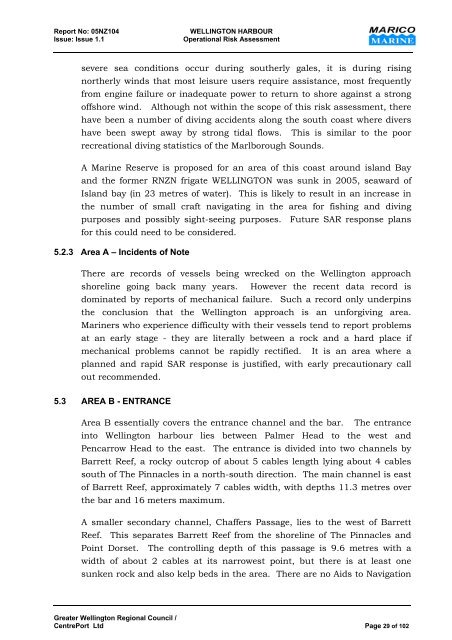MARICO Marine NZ Limited WELLINGTON HARBOUR PORT AND ...
MARICO Marine NZ Limited WELLINGTON HARBOUR PORT AND ...
MARICO Marine NZ Limited WELLINGTON HARBOUR PORT AND ...
Create successful ePaper yourself
Turn your PDF publications into a flip-book with our unique Google optimized e-Paper software.
Report No: 05<strong>NZ</strong>104 <strong>WELLINGTON</strong> <strong>HARBOUR</strong><br />
Issue: Issue 1.1 Operational Risk Assessment<br />
severe sea conditions occur during southerly gales, it is during rising<br />
northerly winds that most leisure users require assistance, most frequently<br />
from engine failure or inadequate power to return to shore against a strong<br />
offshore wind. Although not within the scope of this risk assessment, there<br />
have been a number of diving accidents along the south coast where divers<br />
have been swept away by strong tidal flows. This is similar to the poor<br />
recreational diving statistics of the Marlborough Sounds.<br />
A <strong>Marine</strong> Reserve is proposed for an area of this coast around island Bay<br />
and the former R<strong>NZ</strong>N frigate <strong>WELLINGTON</strong> was sunk in 2005, seaward of<br />
Island bay (in 23 metres of water). This is likely to result in an increase in<br />
the number of small craft navigating in the area for fishing and diving<br />
purposes and possibly sight-seeing purposes. Future SAR response plans<br />
for this could need to be considered.<br />
5.2.3 Area A – Incidents of Note<br />
There are records of vessels being wrecked on the Wellington approach<br />
shoreline going back many years. However the recent data record is<br />
dominated by reports of mechanical failure. Such a record only underpins<br />
the conclusion that the Wellington approach is an unforgiving area.<br />
<strong>Marine</strong>rs who experience difficulty with their vessels tend to report problems<br />
at an early stage - they are literally between a rock and a hard place if<br />
mechanical problems cannot be rapidly rectified. It is an area where a<br />
planned and rapid SAR response is justified, with early precautionary call<br />
out recommended.<br />
5.3 AREA B - ENTRANCE<br />
Area B essentially covers the entrance channel and the bar. The entrance<br />
into Wellington harbour lies between Palmer Head to the west and<br />
Pencarrow Head to the east. The entrance is divided into two channels by<br />
Barrett Reef, a rocky outcrop of about 5 cables length lying about 4 cables<br />
south of The Pinnacles in a north-south direction. The main channel is east<br />
of Barrett Reef, approximately 7 cables width, with depths 11.3 metres over<br />
the bar and 16 meters maximum.<br />
A smaller secondary channel, Chaffers Passage, lies to the west of Barrett<br />
Reef. This separates Barrett Reef from the shoreline of The Pinnacles and<br />
Point Dorset. The controlling depth of this passage is 9.6 metres with a<br />
width of about 2 cables at its narrowest point, but there is at least one<br />
sunken rock and also kelp beds in the area. There are no Aids to Navigation<br />
Greater Wellington Regional Council /<br />
CentrePort Ltd Page 29 of 102
















